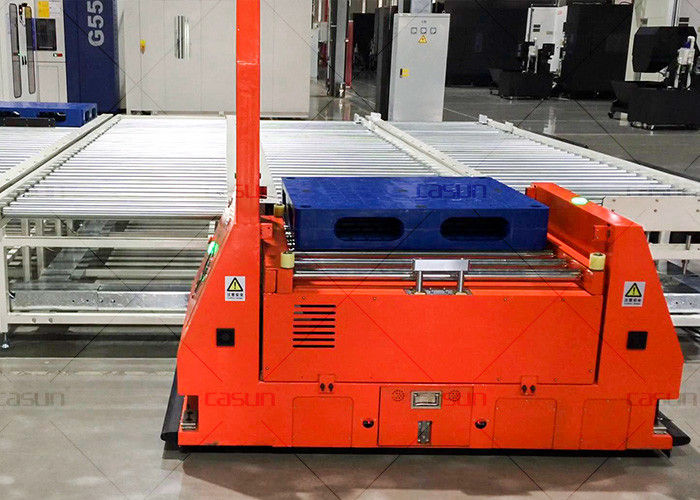Benefits of AGV: 11 Unbeatable Advantages Explored
There are two advantages of using Automated Guided Vehicles, these pros are Money and Health & Safety. In the following lines I explain the 11 top benefits of deploying an automated guided vehicle system.
AGVs Unleashed: 11 Ways They Enhance Operational Performance
 My name is Alfredo Pastor... I sell mobile robots and I love them ❤. There are a bunch of pros of using agvs, but at the end of the day, all of them must be economically efficient.
My name is Alfredo Pastor... I sell mobile robots and I love them ❤. There are a bunch of pros of using agvs, but at the end of the day, all of them must be economically efficient.
Check my list of 11 strenghts of automated guided vehicles. By the way, if you register in agvnetwork, you'll be able to download nice documents related to mobile robots.
The 11 main advantages of automated guided vehicles are:
🤑 The first good reason, it’s a question of money. Money drives innovation, advancements, and opportunities. But beware... not all that glitters is gold.
Based on my experience in the field, it's evident that while 90% of customers initially consider AGVs primarily for cost reduction, there are numerous other advantages that are often initially disregarded but ultimately become indispensable to AGV users. 🤓.
Before diving in... Check this video where I explain these "soft" benefits. 👇

1. Direct Labor Costs Reduction
Let’s be honest. This is the main reason for companies to start thinking about mobile robots (AGVs and AMRs). Anything that helps the bottom line of a company’s expense sheet will be considered for adoption.

If you install a mobile robot, you will immediately calculate how many people you can transfer from non-valued tasks (such as transporting material) to value-added operations such as production activities.
According to the US Bureau of Labor Statistics (BLS), the average Industrial Truck and Tractor Operator salary in the United States is $43,899 as of December 27, 2023, but the range typically falls between $36,357 and $52,825.
It means an average of $21 per hour
It’s understandable that companies consider automation as a way to reduce labor costs.
Everything depends on the initial investment in the AGV or AMR system and the number of workers that will be substituted by them.
One of the key points is the number of working hours of the robotic system. If you expend $500K for a mobile robot project, this amount will be the same (almost) if the robot works 8 hours or 24 hours, 5 days a week or 7 days a week.
So if you want to know if your self-driving robot project makes sense, do not forget to download the AGV ROI Excel tool calculator to understand better the variables involved in an AGV system payback.
Of course, it's free for agvnetwork's registered members ????
| Click here to download the EXCEL tool |
Let's go ahead !
The first direct direct saving is the "operator cost", A mobile robot working 3 shifts could substitute 2 or 3 operators (wages, benefits, overtime, vacation, etc).
There are many variables involved in the a mobile robot system cost, this article dives into them: AGV Investment
2. AGVs Help Avoid Workforce Shortages
According to the US Bureau of Labor Statistics (BLS), in the last years the Warehousing and Storage sector of the US economy grew dramatically driven largely by a rising economy and increased ecommerce sales across the country.

The global Warehousing and Storage market was estimated at USD 490,830.22 million in 2023, and it’s anticipated to reach USD 639,067.24 million in 2028 (source).
Unfortunately, this massive growth in hiring and demand for workers has come with a number of significant downsides.
One of the most critical of these is the fact that the warehousing and order fulfilment industries are experiencing a significant labor shortage, which threatens this continuation of this growth.

In practically every industry and companies are experiencing major labor shortages. These year-round shortages are felt especially hard during a business’ peak period, those times of the year when sales spike, demand is through the roof and orders seem to be flooding in consistently (have you heard about the BLACK Friday?)
There are three primary drivers behind the current warehouse labor shortage.
📉 Low unemployment rates
👴🏼 Aging workforce: As employees near retirement, the ability to get new employees into the business and attract people into this type of work is a real challenge.
🗺 Location: land costs push companies to move operations into less expensive areas, which tend to have less qualified personnel.
The shortage of workers has hit the trucking and logistics industry particularly hard.
Investing in Automated Guided Vehicles (AGV) or Autonomous Mobile Robots (AMR) can quickly return ROI and limit the need for unskilled employees, thus allowing more investment in skilled labor as competition becomes fiercer in the coming years.
Mobile Robots are beneficial for companies operating 24/7 as owners would not have to worry about a shortage of extra shift workers.
3. Mobile Robots Avoid Mistakes
Each mistake is expensive, whether it’s a missed pick or a material delivered to a wrong destination.
According to a GE Digital survey, 23% of all unplanned downtime in manufacturing is the result of human error.
Another study performed by AMAZON Web Services in 2017 reported that S&P companies saw a loss of $150 million. The cause according to Amazon? Human error.
Human error is the greatest contributor to unplanned downtime in the industry. Mistakes happen when workers are tired or distracted.
Any manufacturer who's had to shut down an entire production line because someone misread a label can agree.
Of course, the robotic systems don’t get distracted or fatigued. Forget about delivering the wrong material to the wrong place. If the autonomous system is properly programmed, you can be sure that there will be no mistakes.
4. Automation increases Traceability and Inventory accuracy

Mobile Robots interact with the environment relaying the position of the vehicle to the dispatching systems in real-time, which greatly enhances the efficiency of production lines and warehouses.
Mobile robots, togheter with drone warehouse inventory systems can be integrated into the factory MES, WMS, ERP, etc to combine logistics and production processes to enhance operational efficiency.
Companies do not have to waste time on manual inventory tracking and can eliminate expensive errors and ensure timely delivery.
In addition, to the obvious improvements in accuracy and productivity, by integrating AGVs with a warehouse control system or a warehouse management system, you can streamline processes such as inventory and materials ordering.
A system like this could bring the following benefits to a warehouse:
1) optimizing warehouse storage through demand analysis of available storage space and automatic shelf adjustments.
2) streamlining warehouse management by supporting inventory business processes, like material requisition and procurement; and
3) gaining total control with flexible management strategies, user-based permission configuration, and warehouse visualization
5. Permit Layout Freedom
I like this one. If you compare an automated forklift with a manned forklift, you probably will not find any significant layout advantage.

But remember that mobile robots can substitute other equipment such conveyors or assembly lines.

Traditional Fixed Assembly Line
An assembly line performed by AGVs rather than a traditional floor chain or moving mat, offers better layout and workflow optimization.
Mobile robots are not obliged to follow a line, and you can create as many deviations and external positions as necessary. You can create deviations for quality checks, additional operations, product customizations, etc.

While you do not need any civil work for installing mobile robots, you could relocate your flexible assembly line in another area of your plant… or you can even move the line to another plant even if it’s abroad.
If we compare mobile robots with traditional conveyors, I cannot avoid talking about the Unit Load AGVs that are built to carry one or several unit loads at a time to and from conveyors, stands, end-of-line equipment (palletizers, wrappers, robots) as well as automated storage and retrieval systems (AS/RSs).
Unit Load AGVs represent a huge step forward in terms of layout when compared with traditional conveyors.

While mobile robots "move" (great conclusion!!), they are not fixed so the working area remains open and free for people and forklifts.
This is very important, not only for traffic viability but also for SAFETY reasons because fixed conveyors represent a physical barrier that blocks and limits escape corridors.
6. AGVs and AMRs are easy to Scale compared to fixed equipment
As your operations expand, it is easy to add additional mobile robtos as necessary.
It is true that the scalability can also be performed with manual vehicles, so I do not think this is a real advantage against manned forklifts.
If we compare mobile robots to Fixed Equipment instead, robots are much more scalable.
Robots allow you to avoid an incredibly high initial investment because, instead of purchasing a big fixed conveyor (for example), you can start with only a few AGVs and eventually expand your fleet as customers demand increases.
You can easily increase system output simply by adding more driverless vehicles without the need of any civil works.
7. Automated Guided Vehicles Increase Safety

According to the Safety in Numbers and OHCSA report:
- There's a staggering 90% likelihood that a forklift will be involved in a serious injury or fatal accident during its operational lifespan.
- Annually, there are 61,800 minor injuries, 34,900 severe injuries, and 85 deaths directly linked to forklift incidents.
- Considering the nearly 900,000 forklifts active in the United States, this equates to a concerning 1 in 10 chance of each forklift in your facility being implicated in an accident this year.
- Shockingly, almost 80% of forklift accidents involve a pedestrian, and in the United States, 1 in every 6 workplace fatalities are forklift related.

We already had this info in mind, but these numbers are terrible when we see them all together in one place.
This is the first advantage that is not necessarily measured in terms of money.
SAFETY FIRST
An AGV must be safe. Automated Guided Vehicles are programmed with safety in mind, and as such are crammed full of cameras, lasers, and other sensors that allow them to safely operate around personnel and structures.
The AGVs travel on designated paths, which have been prescribed by users, thus areas with high traffic or a non-safe path can be avoided.
By contrast, equipment run by human operators, such as forklifts, do not have as many built-in safety mechanisms and ultimately rely on human input, which can be compromised in any number of ways.
Whereas a human operator always has the potential to become distracted or fatigued, and therefore can cause an accident, AGVs do not have these concerns.
Safety is a very important subject explained in this article: AGV Safety Systems and this whitepaper (register to download):
 Of course, again... free for agvnetwork's registered members 😎
Of course, again... free for agvnetwork's registered members 😎
| Click here to download the WhitePaper |
8. Health and Ergonomic Working Conditions Improvement
Mobile Robots can operate in conditions that humans either aren’t able to operate in or in conditions that humans don’t operate optimally in, such as in extreme heat or cold or around hazardous materials such chemical factories or nuclear plants.
A great example is represented by UV Disinfection Robots used to kill virus and bacteria. UVC kills almost everything. It is harmful for viruses, and it also harmful for humans. Thus, autonomous robots are a great base to transport these cleaning devices.
Mobile Robots also reduce the need for humans to move heavy loads or to perform repetitive tasks.
For example, mobile robots in hospitals are becoming more and more convenient and are assuming non-value-added tasks such as pushing the 800 to 1,000-pound linen trollies that requires considerably effort and fatigue.
Another example is clearly represented by the Good-to-Person philosophy implemented in ecommerce warehouses.
Rather than having an operator walking along infinite corridors while looking for material in a warehouse (wasted time, energy, and effort), the material and goods come to the operator thanks to autonomous warehouse robots carrying shelves to picking stations.
There are infinity examples about improved ergonomics, for example, an Assembly Line performed by mobile robots can incorporate many tools improving operator ergonomics such lifting tables, rotating devices, etc. These tools will minimize operator movements and will avoid non ergonomic operations.
With 24/7 operability and high production output, AGV systems ensure worker safety while maximizing production.
Better Safety Conditions also means “Money”... or saving money
We have written that Safety, Health and Ergonomics are not necessarily related to economics.
Well, the truth is that, always keeping in mind that operator’s safety and healthy working conditions are a must and all of this increased safety leads to reduced costs and reduced operational downtime, which can ultimately increase the profitability of overall operations.
9. Minimize Infection Risk
This the “newest” advantage, or at least it is something that all the industries are starting to think about.

After the recent COVID-19 pandemic situation all factories and property managers are worried about worker’s illness transmission.
This concern is not new to the Hospital Industry where mobile robots are seen as an effective way to reduce Hospital Acquired Infections (HAI).
According to the US Centers for Disease Control and Prevention, 1 in 25 patients in severe care hospitals contract at least 1 HAI, and every year 75,000 deaths are attributed to HAIs.
Humans are an effective way to transmit infections, thus reducing the workers headcount minimize the contagion probability.
Having mobile robots instead of people performing non value-added ensures operations continuity in case of lockdowns or restrictions on social movements.
10. Mobile Robots Reduce User Indirect Costs
Don’t forget about the indirect cost reductions achieved thanks to mobile robots.
Less staff means less need for indirect costs. Facilities will expend less in:
Utilities such water, cleaning services, parking. For example, AGVs can operate in lights-out environment thus saving in illumination lighting.
Human resources (recruitment and training).
Indirect cost due to forklift damages. Thanks to their Safety Systems, AGVs do not run into other equipment, pallets and containers, inventory, walls and racks, etc.
Imagine and AGV moving radioactive material. AGVs move smooth and are equipped with many safety devices to avoid contacts. You could move this material manually, but you would never be sure that that people don’t hit anything.
AGV’s run at a constant speed (average speed), which means no sudden jerks and increased safety of the product.
More efficient usage of batteries and vehicles maintenance cost
AGVs are more energy efficient than forklifts because AGVs’ energy consumptions is lower. AGVs run at a given speed and accelerations and decelerations are controlled and programmed to save energy.
Moreover, each type of battery has its own ideal operation cycle. It means that in order to optimize battery life it is necessary to perform charging cycles at a given depth-of-discharge (DOD). AGVs can be programmed to be charged at a that given DOD. Manual forklifts instead, are used by the operators and are usually recharged when the vehicle cannot run anymore, thus decreasing battery life.
The charging strategy concepts are explained into detail in this article: AGV Battery charging System
There are many other examples of indirect cost savings, for example, AGVs offer higher capacity to deliver orders and improve KPIs, service-level agreement (SLA), On time Delivery, etc helping to avoid customer penalties.
11. Mobile Robots Increase Productivity
All these elements together: reduced direct labor cost, less indirect cost and mistakes, better safety conditions inevitably lead to enhanced overall productivity.

Unlike humans, mobile robots do not get tired, distracted, and do not stop to have a coffee. AGV robots don’t need to take breaks and can work 24/7.
AGVs are programmed to perform the best route or to perform a given task in an efficient way.
By replacing the human factor with AGVs, you remove some of the potential for inaccurate workflows and operations.
Automation reduces waste and increase overall output, allowing your operations to become more productive and accurate.
If your company is working 2 shifts, you could even rethink your operations and perform some operations during an “automated” extra night shift.
Imagine a warehouse managed by Automated Forklifts. During the night, the AGVs could reorganize the warehouse locations, move the FIFO or simply optimize the warehouse for the day after operations.
You do not have to pay more for those overtime night operations.
Overall productivity is a MUST in more and more competitive markets such as ecommerce where industry changes are forcing warehouse operators to do more with the same tools and people.
Warehouse and fulfilment centres are using collaborative mobile robots that use powerful cloud-based software, machine learning and artificial intelligence to increase picker’s productivity.
It has been demonstrated that AMRs can dramatically increase picks per hour, which means more capacity to complete orders with less staff. Some suppliers indicate that picking performance can be boosted by x2 or x3. So, a traditional operator with 70 picks per hour can easily meet 150 picks per hour aided by mobile robots.
|
Related articles Disadvantages of Automated Guided Vehicles AGV ROI Calculation - Discover how to calculate a Forklift AGV System Return on Investment What are the top 20 warehouse automation trends? Warehouse Autonomous Mobile Robots - All the types of robots and their applications in warehouses |
 Written by Alfredo Pastor Tella (agvnetwork editor).
Written by Alfredo Pastor Tella (agvnetwork editor).
Follow me on LinkedIn... let's create a mobile robot community to discuss and learn about these outstanding systems.





